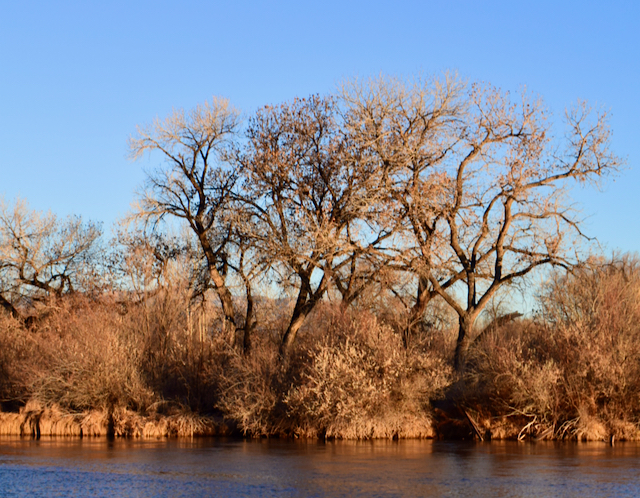The mid Rio Grande Bosque (Spanish for woods) is the largest cottonwood forest in the United States. In Fall, the golden ribbon lining the river is thrilling. It is an ecosystem with its own unique collection of interdependent plants and animals which has existed since prehistoric times. This type of ecosystem exists in the US mostly in the arid Southwest along the Rio Grande. The cottonwoods give structure and a canopy to the bosque, providing shade and shelter. They have a naturally occurring understory of coyote willows, New Mexico olive, and indigo bush, and they house animals such as porcupine, ducks, and geese. The latter are spotted easily as one walks through the Bosque in Fall. However, this is all vulnerable to change.

We have slowly changed the forest by establishing dams to control the rate and timing of river flow and by channelizing the river with levees and jacks. Flood control is necessary for humans to live in the flood plain of the river, but at the same time these trade-offs slowly shift the ecosystem. The cottonwoods can not regenerate themselves without periodic flooding, and so the understory becomes invaded with introduced species such as Russian olive, Siberian elm, salt cedar, and tree-of-heaven. Animal species such the New Mexico meadow jumping mouse, southwestern willow flycatcher, and the Rio Grande silvery minnow disappear.
The question now is whether we try to restore the Bosque with water management and plantings for restoration of the riparian environment or loose the cottonwoods and let the area evolve with new species and wildlife more adapted to the urban environment we have created. And do we care?
The act of caring is usually meted out to the vulnerable among us: our children, fellow humans, our pets. But what about all the other species in our environment? How does caring develop for plants and wildlife?
People are attracted to positive emotions and become connected to things which are beautiful – for example, sunsets. We stop and watch the shifting array of color and the motion of the clouds. We marvel at this beauty. It is hard to imagine life without sunsets. The beauty of the Bosque invites us to pause under the canopy of the cottonwoods, to look for the porcupines hiding in the trees, and maybe spot a beaver swimming in a ditch or pond. Laura Paskus and KNME have produced a video inviting you into the bosque at this time of year.
If the Bosque is to be restored, then those of us living here have to know and love it, becoming connected enough to its beauty to generate action. People can see their actions make a difference when they pick up trash, carefully prune back overgrowth along paths, and plant and tend new coyote willow and young cottonwood.
The future of our Bosque is in our hands.
The Nature Center on Candelaria NW is selling attractively designed stickers of the common plants and animals of the bosque. They are perfect for your car and to show your support.

